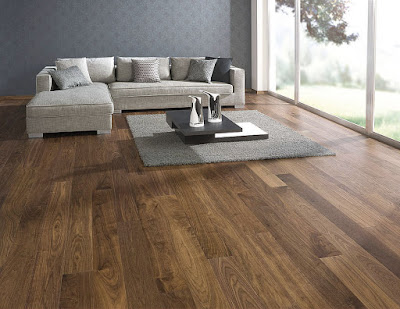Solid Wood Flooring
Solid wood flooring is precisely what the name indicates: a compacted piece of wood from top to bottom. The thickness of solid wood flooring can vary, but commonly ranges from ¾” to 5/16”. One of the many benefits of solid wood flooring is that it can be refinished and sandpapered many times. Solid wood flooring can be set up above or on grade. It is usually obtainable in narrow strips, wide planks, and parquet squares.
Three main types of solid wood flooring are:
• Strip flooring - This type of flooring is indicated by the thickness and width of the wood planks. Strip flooring has a set width, but the thickness may differ. Strip flooring ranges in thickness from 5/16 of an inch to 3/4 of an inch wide. It is available only in widths of 1 1/2 inches, 2 inches and 2 1/4 inches.
• Plank flooring - Plank flooring only comes in two thicknesses, but not like strip flooring, the widths can be different. It is available only in thicknesses of 1/2 inch or 3/4 inch and a range of widths from 3 inches to 8 inches.
• Parquet flooring - Parquet floors have a very unlike look from usual hardwoods. They are made up of geometrical patterns composed of individual wood slats held in place by mechanical fastening or an adhesive.
Engineered Wood Flooring
Engineered-wood flooring was make known to North America in the mid-1980s and rapidly became the most well-known type of do-it-yourself wood floor. It is combination of three or more wood layers glued together into long planks that has top layer composed of a thin solid-wood veneer. This laminated construction generates a floor that's much more dimensionally stable than solid-wood flooring, so it's less likely to cup, split, shrink, or warp. There are more than two dozen wood species to choose from, including both softwood and hardwood.
The main reason why DIYers love engineered-wood flooring is that the planks snap together and "float" over a thin foam-rubber underlayment. There's no nailing or gluing required so the installation process is swift and neat. Plus, the planks can be laid directly over most existing floors, as long as the surface is hard, flat, and in good condition.
Engineered wood floors are real wood floors that are man-made using multiple layers of different wood veneers. The sub layers can be made of the same species or of different species. The grain of each layer runs in different directions, which makes it very steady. This means that the wood will expand and contract less than solid wood flooring during variations in humidity and temperature. The top layer of engineered wood flooring comprises of high-quality wood.
Detailed information at http://www.popularmechanics.com/home/interior-projects/how-to/a7913/which-kind-of-hardwood-flooring-should-you-choose/
Related Links:
http://www.wfca.org/Pages/Hardwood-Flooring-Types.aspx
http://woodfloors.org/types.aspx
http://home.howstuffworks.com/home-improvement/home-diy/flooring/hardwood-floor2.htm



